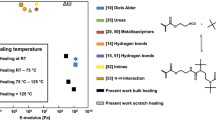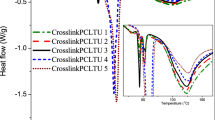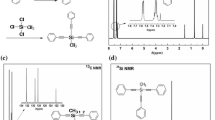Abstract
Based on Diels-Alder reaction, a furyl-telechelic semicrystalline polycaprolactone was crosslinked by a tris-maleimide crosslinker. The synthesized precursors and network were fully characterized via proton nuclear magnetic resonance (1H NMR) and Fourier transform infrared (FT-IR) spectroscopies, gel permeation chromatography (GPC), thermogravimetric analysis (TGA), differential scanning calorimetry (DSC) and wide-angle powder X-ray diffraction (XRD) measurements. The obtained material showed mendability of scratches under thermal treatment, as evidenced by optical microscopy and tensile analysis. The mending process was a combination of the shape recovery effect favoring scratch closure and the re-crosslinking of the cleaved Diels-Alder bonds at temperatures slightly above the melting transition of polycaprolactone chains. A scratch healing efficiency determined by tensile tests of about 70 % was achieved.












Similar content being viewed by others
References
Blaiszik BJ, Kramer SLB, Olugebefola SC, Moore JS, Sottos NR, White SR (2010) Self-healing polymers and composites. Annu Rev Mater Res 40:179–211
Hillewaere XKD, Teixeira RFA, Nguyen L-TT, Ramos JA, Rahier H, Du Prez FE (2014) Autonomous self-healing of epoxy thermosets with thiol-isocyanate chemistry. Adv Funct Mater 24:5575–5583
Fereidoon A, Ghorbanzadeh Ahangari M, Jahanshahi M (2013) Effect of nanoparticles on the morphology and thermal properties of self-healing poly(urea-formaldehyde) microcapsules. J Polym Res 20:1–8
Rahimi A, Amiri S (2014) Self-healing hybrid nanocomposite coatings with encapsulated organic corrosion inhibitors. J Polym Res 22:1–8
Bergman SD, Wudl F (2008) Mendable polymers. J Mater Chem 18:41–62
Zhang Y, v Y-h, Zhang Z-p (2015) The influence of 2,4-toluene diisocyanate content on the intrinsic self-healing performance of polyurethane at room-temperature. J Polym Res 22:1–6
Cheng C, Bai X, Zhang X, Li H, Huang Q, Tu Y (2015) Self-healing polymers based on a photo-active reversible addition-fragmentation chain transfer (RAFT) agent. J Polym Res 22:1–8
Zhang MQ, Rong MZ (2013) Intrinsic self-healing of covalent polymers through bond reconnection towards strength restoration. Polym Chem 4:4878–4884
Liu Y-L, Chuo T-W (2013) Self-healing polymers based on thermally reversible Diels-Alder chemistry. Polym Chem 4:2194–2205
Mignard N, Okhay N, Jegat C, Taha M (2013) Facile elaboration of polymethylmethacrylate / polyurethane interpenetrating networks using Diels-Alder reactions. J Polym Res 20:1–13
Chen X, Dam MA, Ono K, Mal A, Shen H, Nutt SR, Sheran K, Wudl F (2002) A thermally re-mendable cross-linked polymeric material. Science 295:1698–1702
Tasdelen MA (2011) Diels-Alder “click” reactions: recent applications in polymer and material science. Polym Chem 2:2133–2145
Tian Q, Yuan YC, Rong MZ, Zhang MQ (2009) A thermally remendable epoxy resin. J Mater Chem 19:1289–1296
Zhang Y, Broekhuis AA, Picchioni F (2009) Thermally self-healing polymeric materials: the next step to recycling thermoset polymers? Macromolecules 42:1906–1912
Kavitha AA, Singha NK (2009) “Click chemistry” in tailor-made polymethacrylates bearing reactive furfuryl functionality: a new class of self-healing polymeric material. ACS Appl Mater Interfaces 1:1427–1436
Scheltjens G, Diaz MM, Brancart J, Assche GV, Mele BV (2013) A self-healing polymer network based on reversible covalent bonding. React Funct Polym 73:413–420
Bose RK, Kötteritzsch J, Garcia SJ, Hager MD, Schubert US, van der Zwaag S (2014) A rheological and spectroscopic study on the kinetics of self-healing in a single-component diels–alder copolymer and its underlying chemical reaction. J Polym Sci Part A Polym Chem 52:1669–1675
Lendlein A, Sauter T (2013) Shape-memory effect in polymers. Macromol Chem Phys 214:1175–1177
Lendlein A, Kelch S (2002) Shape-memory polymers. Angew Chem Int Ed 41:2034–2057
Lendlein A, Behl M, Hiebl B, Wischke C (2010) Shape-memory polymers as a technology platform for biomedical applications. Expert Rev Med Devices 7:357–379
Leng J, Lan X, Liu Y, Du S (2011) Shape-memory polymers and their composites: stimulus methods and applications. Prog Mater Sci 56:1077–1135
Xu H, Yu C, Wang S, Malyarchuk V, Xie T, Rogers JA (2013) Deformable, programmable, and shape-memorizing micro-optics. Adv Funct Mater 23:3299–3306
Behl M, Razzaq MY, Lendlein A (2010) Multifunctional shape-memory polymers. Adv Mater 22:3388–3410
Kirkby EL, Rule JD, Michaud VJ, Sottos NR, White SR, Månson J-AE (2008) Embedded shape-memory alloy wires for improved performance of self-healing polymers. Adv Funct Mater 18:2253–2260
Kirkby EL, Michaud VJ, Månson JAE, Sottos NR, White SR (2009) Performance of self-healing epoxy with microencapsulated healing agent and shape memory alloy wires. Polymer 50:5533–5538
Li G, Zhang P (2013) A self-healing particulate composite reinforced with strain hardened short shape memory polymer fibers. Polymer 54:5075–5086
Li G, Ajisafe O, Meng H (2013) Effect of strain hardening of shape memory polymer fibers on healing efficiency of thermosetting polymer composites. Polymer 54:920–928
Rodriguez ED, Luo X, Mather PT (2011) Linear/network poly(ε-caprolactone) blends exhibiting Shape Memory Assisted Self-Healing (SMASH). ACS Appl Mater Interfaces 3:152–161
Luo X, Mather PT (2013) Shape memory assisted self-healing coating. ACS Macro Lett 2:152–156
García-Huete N, Laza J, Cuevas J, Gonzalo B, Vilas J, León L (2014) Shape memory effect for recovering surface damages on polymer substrates. J Polym Res 21:1–10
Zhang J, Niu Y, Huang C, Xiao L, Chen Z, Yang K, Wang Y (2012) Self-healable and recyclable triple-shape PPDO-PTMEG co-network constructed through thermoreversible Diels-Alder reaction. Polym Chem 3:1390–1393
Rivero G, Nguyen L-TT, Hillewaere XKD, Du Prez FE (2014) One-Pot thermo-remendable shape memory polyurethanes. Macromolecules 47:2010–2018
Lu X, Fei G, Xia H, Zhao Y (2014) Ultrasound healable shape memory dynamic polymers. J Mater Chem A 2:16051–16060
Heo Y, Sodano HA (2014) Self-healing polyurethanes with shape recovery. Adv Funct Mater 24:5261–5268
Woodruff MA, Hutmacher DW (2010) The return of a forgotten polymer—Polycaprolactone in the 21st century. Prog Polym Sci 35:1217–1256
Narita M, Teramoto T, Okawara M (1971) Syntheses and reactions of functional polymers. LIV. Syntheses and polymerizations of O-substituted-N-hydroxymaleimides. Bull Chem Soc Jpn 44:1084–1089
Nguyen L-TT, Gokmen MT, Du Prez FE (2013) Kinetic comparison of 13 homogeneous thiol-X reactions. Polym Chem 4:5527–5536
Mellouki A, Herman M, Demaison J, Lemoine B, Margulès L (1999) Rotational analysis of the ν7 band in furan (C4H4O). J Mol Spectrosc 198:348–357
Mani R, Bhattacharya M (2001) Properties of injection moulded blends of starch and modified biodegradable polyesters. Eur Polym J 37:515–526
Acknowledgments
This research was fully supported by Vietnam National Foundation for Science and Technology Development (NAFOSTED) under grant number “104.02-2013.19”.
Viet Q. Nguyen is acknowledged for the assistance with the FT-IR and GPC measurements. Tri M. Phan is acknowledged for the assistance with the tensile tests.
Author information
Authors and Affiliations
Corresponding author
Rights and permissions
About this article
Cite this article
Nguyen, LT.T., Nguyen, H.T. & Truong, T.T. Thermally mendable material based on a furyl-telechelic semicrystalline polymer and a maleimide crosslinker. J Polym Res 22, 186 (2015). https://doi.org/10.1007/s10965-015-0827-y
Received:
Accepted:
Published:
DOI: https://doi.org/10.1007/s10965-015-0827-y




